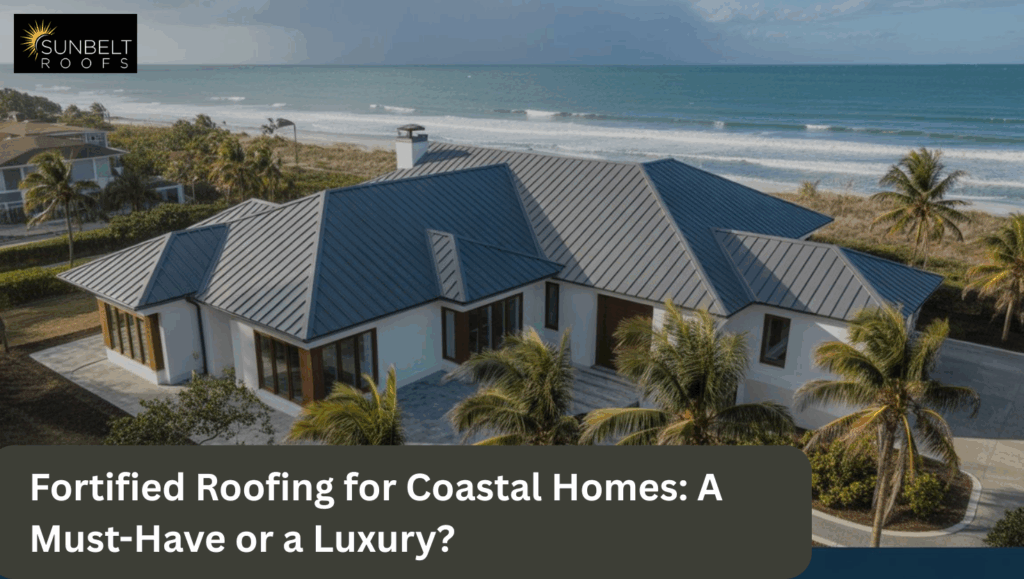
The coast offers beautiful sights and ocean breezes, but coastal homeowners must deal with mercurial weather, high winds, and severe storms.
In this blog, we discuss fortified roofing for coastal homes and how it is altering our perceptions of roofing durability and protection.
Understanding the Challenge of Roofing in Coastal Homes
Inland homes do not have to deal with the salty air, heavy winds, and hurricanes like coastal properties do. For coastal homes, the combination of these factors presents a unique roofing problem. A traditional roof simply cannot withstand the salty air and hurricanes.
Common Threats in Coastal Areas:
- Saltwater corrosion on metal components
- Hurricane-force winds
- Roof uplift due to improper fastening systems
- Water intrusion during storm surges
Due to these roofing threats, coastal homes require wind-resistant roofing and improved fortified roofing standards.
What Is a Fortified Roof?
What is a fortified roof, and how is it different from a regular roof? A common perception is that a normal roof is static. However, a fortified roof can withstand harsh winds, heavy rain, and even hurricanes.
Definition:
Fortified Roofing Systems are high-performance roofs built to withstand severe storms and decrease the risk of damage based on guidelines from the Insurance Institute for Business & Home Safety (IBHS).
Key Characteristics of Fortified Roofs:
- Sealed roof decks to prevent water leakage
- Enhanced attachment of shingles and decking
- Superior edge protection against wind uplift
- Resistance to hail and flying debris
These roofing systems are best for homes in the coastal region due to the focus on resiliency.
Key Features of a Fortified Roofing System
Upgrading to a fortified roofing system means rebuilding the roof to one that is built for protection and performance.
What Makes It Different?
- Ring shank nails: Improved grip on shingles that withstand harsh winds
- Enhanced flashing systems: Seal off water leaks at the edges and vents of the roof
- Stronger starter strips and underlayment: Slap in an additional measure of boundary defense
This house’s Fortified Roofing Metairie fact not only helps homes in coastal regions become more resilient, but it is also built to withstand harsh climates.
Why Fortified Roofing Makes Sense for Coastal Homes
For homeowners in fortified roofing for coastal homes, hurricane-grade roofing is much more than an impulsive purchase it is a practical, long-lasting investment.
Benefits Include:
- Dramatically lower repair and maintenance long-term expenses
- Lowering the risk of storm damage
- Stronger, more secure roofs lead to better energy efficiency
- Less stress and worry during hurricane season
Using wind-resistant roofing may lower the costs of insurance. Most wind-resistant roofing systems allow homeowners to insure their properties at much better rates.
Is Fortified Roofing a Luxury or a Smart Investment?
Compared to a standard roof, fortified roofing increases the expense slightly more than average. Still, the savings on insurance and the value of the home’s resale make fortified roofing pay off much more in the long run.
Reasons It’s a Smart Investment:
- Will likely increase a home’s resale value
- Insured homes may gain discounts on policies
- Prevents the need to pay for expensive emergency repairs
- Delivers expected value long into the future
Coastal homeowners appreciate that the value and savings in fortified roofs is greatly beneficial, especially during resale.
How to Get Started with a Fortified Roofing System
Looking to upgrade? Here is what you need to learn before moving to wind-resistant roofing.
Steps to Take:
- Work with a certified contractor for IBHS-compliant roofing systems
- Determine the condition of your present roof and areas that require work for eligibility and upgrades
- Select materials that fulfill Fortified criteria
- Schedule installation during the off-season for improved time slots.
- Request for inspection and certification to ensure everything is in order for compliance.
FAQs
Q.1 Is fortified roofing worth it for beach homes?
-> Definitely. Homes situated near the beach have heightened risks of wind and water damage, and a fortified roof provides additional protection.
Q.2 Can I upgrade my existing roof to a fortified system?
-> Yes, based on the current condition and structure of the roof. A contractor can determine if retrofitting is feasible.
Final Thoughts
Coastal fortified roofing is not just a protective barrier; instead, it acts as an investment for safety, savings, and stability. With the frequency of extreme weather events, fortified roofing ensures your home is well-prepped for anything nature throws your way.
If you’re coastal, fortified roofing is a powerful upgrade and is a necessity, not a luxury.
